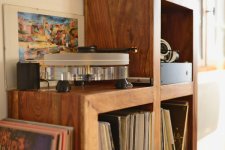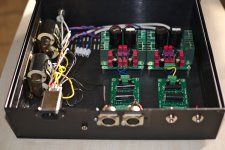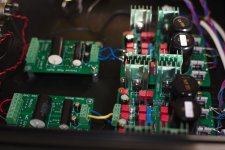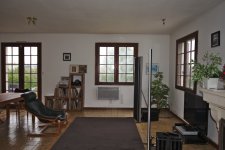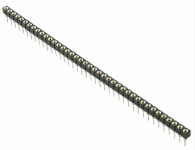hi all,
i enjoy my retro phono stage for some time now, one board is noisier and have less gain too than the other but it's fine it's not too much noisy.
I lowered R2/13 values for the "bad" board for ajust the gain.
The good boad is really really quiet and work well with R18/19 shunted.
The bad one have no sound with R18/19 shunted
So i set up 22 ohms Rinput for both.
Best regards from France
Some pictures :
i enjoy my retro phono stage for some time now, one board is noisier and have less gain too than the other but it's fine it's not too much noisy.
I lowered R2/13 values for the "bad" board for ajust the gain.
The good boad is really really quiet and work well with R18/19 shunted.
The bad one have no sound with R18/19 shunted
So i set up 22 ohms Rinput for both.
Best regards from France
Some pictures :
Attachments
Russ/Brian,
Been using the Retro Lo-Z for a while. I now want to change my preamp input to single-ended. I recall that the Ventus EZ was mentioned as a good way to convert balanced to single-ended. My Retro is mounted in the same box with the preamp and I can mount the Ventus right next to it. Would it be advantageous to reduce the input/feedback resistors from 4.99k to around 1k or so? I am referring to R2,3,4,5 in the Ventus schematic.
Since the Retro has only 21 Ohm output impedance my thinking is that reducing those resistors would improve the noise characteristics.
Thanks, Mike
Been using the Retro Lo-Z for a while. I now want to change my preamp input to single-ended. I recall that the Ventus EZ was mentioned as a good way to convert balanced to single-ended. My Retro is mounted in the same box with the preamp and I can mount the Ventus right next to it. Would it be advantageous to reduce the input/feedback resistors from 4.99k to around 1k or so? I am referring to R2,3,4,5 in the Ventus schematic.
Since the Retro has only 21 Ohm output impedance my thinking is that reducing those resistors would improve the noise characteristics.
Thanks, Mike
Finished my Retro Lo-Z yesterday - I'd had a couple of delays because of a badly fitting case from China but they sorted it amicably. Gains a little low for my Zyx R50 Bloom (0.24mV) but I dare say from what others have said I can fix that with a swap of resistors.

At first there was a bit of hum close up to the speakers but that was solved by moving the phono stage further away from my turntable speed controller.
First impressions, pretty good indeed.

At first there was a bit of hum close up to the speakers but that was solved by moving the phono stage further away from my turntable speed controller.
First impressions, pretty good indeed.
Hello IanLenco. Is your name referring to the Lenco idler drive?
Well deduced Rich
Thanks. I did see that in the earlier posts but wasn't sure exactly which ones to buy - I'm very much a novice at this electronics stuff.
Here ia what I used.... Digikey part # A460-ND
You can push the metal sockets out of the black plastic shroud and solder them individually.
Attachments
Well deduced RichI have rebuilt several - they're over on Lencoheaven.net
Kewl! I'm at 1 and 1/2....lol The complete 'one' is in the members table thread under my screen name while the 1/2 is in the PTP section.
Here ia what I used.... Digikey part # A460-ND
You can push the metal sockets out of the black plastic shroud and solder them individually.
Many thanks.
Kewl! I'm at 1 and 1/2....lol The complete 'one' is in the members table thread under my screen name while the 1/2 is in the PTP section.
Nice Rich! Love your veneer work. I'm just plain Ian over there - you can see some of mine in the gallery. Have you built a Retro? If you have, how do you find it?
Nice Rich! Love your veneer work. I'm just plain Ian over there - you can see some of mine in the gallery. Have you built a Retro? If you have, how do you find it?
Thank you! I remember now!
"Ian (no, it's not a mistake - they are all his!! )."
My fav was the one with the split or separated from main plinth arm board!
I did not go with a Retro. A forum friend did and loves it. I went the Bottlehead Eros route.
Retro Lo-Z build finished. Love it!
Dear all,
I have just finished my Retro Lo-Z kit build, and I am pleasantly surprised and impressed by the clean sound and the low noise levels (both hum and hiss) the Retro achieves – well below most vinyl surface noise. And in such a small package, too! Rich, thank you for a wonderful design! And Brian, thank you for the exemplary kitting!
I managed to squeeze the two boards plus a switching power supply board I ‘designed’ (using a pair of Mean Well IRM-15-15 modules with some added CLC conditioning) into a (approx.) 7"×4"×1" cast aluminium box (Hammond 1590DD). That left just enough room for a pair of Neutrik XLR output sockets and grommets for the mains and input leads.
The whole assembly is attached to the underside of my Linn Basik/Akito/AT-OC9 turntable combo, so the – screened 4-core – input cable run from the tonearm socket is only a few inches. The mains power comes from the Basik’s power board so the Retro gets switched on and off with the turntable motor. The power switching ‘plop’ is muted enough not to cause any problems at normal listening levels (which in my case tend to be highish), and the output DC voltage spike quickly drops and then stabilises at 1*mV or less within a couple of seconds. Even so, I am considering leaving the Retro boards powered on 24/7 (like the rest of the amp chain and sources).
I decided to keep the Retro’s 100*Ω input resistors (R18 & R19), as I prefer the OC9 – this is the original model, BTW – in its ‘restrained’ mode, and I increased the gain by reducing the value of both R2 and R13 from 1*kΩ to 250*Ω. Works perfectly.
I have only one minor niggle (or perhaps two, depending on how you look at it):
After initial assembly one of the boards failed to produce an output signal. I tracked the error down to a bare solder joint on one of the premounted ICs. Easy to fix, so no great deal.
Initially all was well with the second board, but after a while I noticed that the mains switch ‘plop’ on that channel had become a ‘thump’ and also that the woofer cones on that channel moved an appreciable distance before they settled at zero excursion (apparently the preamp’s DC offset servo works very well and quick enough to avoid the power amp’s DC protection from cutting in). I found that the Retro board on the faulty channel had decided to increase its output DC offset from the original value of 1.1*mV to a whopping 666*mV (actually it was closer to 667*mV, but 666 it must be). I found a dry solder joint on another IC. This time it wasn’t totally bare like the first one, so it was much harder to spot and had escaped detection when I rechecked things after finding the bare joint on the other channel. Anyway, easily cured and no harm done, but anyone contemplating a new Retro build from the kit (which I can highly recommend) might do well to closely inspect the IC solder joints before proceeding any further. After all, some DC-coupled amp combinations might not be as forgiving as mine.
BTW, my power amps are Hypex NC400, and the preamp is the excellent, nay fantastic, 8×2 Differential Preamp that Tom Christiansen designed for/with me (and built), and which is sold via Neurochrome Audio: Precision high performance audio circuits for the DIY market.. Rock-solid switching/buffering/amplification with noise levels well below the audibility threshold. Also highly recommended!
Marcus
Dear all,
I have just finished my Retro Lo-Z kit build, and I am pleasantly surprised and impressed by the clean sound and the low noise levels (both hum and hiss) the Retro achieves – well below most vinyl surface noise. And in such a small package, too! Rich, thank you for a wonderful design! And Brian, thank you for the exemplary kitting!
I managed to squeeze the two boards plus a switching power supply board I ‘designed’ (using a pair of Mean Well IRM-15-15 modules with some added CLC conditioning) into a (approx.) 7"×4"×1" cast aluminium box (Hammond 1590DD). That left just enough room for a pair of Neutrik XLR output sockets and grommets for the mains and input leads.
The whole assembly is attached to the underside of my Linn Basik/Akito/AT-OC9 turntable combo, so the – screened 4-core – input cable run from the tonearm socket is only a few inches. The mains power comes from the Basik’s power board so the Retro gets switched on and off with the turntable motor. The power switching ‘plop’ is muted enough not to cause any problems at normal listening levels (which in my case tend to be highish), and the output DC voltage spike quickly drops and then stabilises at 1*mV or less within a couple of seconds. Even so, I am considering leaving the Retro boards powered on 24/7 (like the rest of the amp chain and sources).
I decided to keep the Retro’s 100*Ω input resistors (R18 & R19), as I prefer the OC9 – this is the original model, BTW – in its ‘restrained’ mode, and I increased the gain by reducing the value of both R2 and R13 from 1*kΩ to 250*Ω. Works perfectly.
I have only one minor niggle (or perhaps two, depending on how you look at it):
After initial assembly one of the boards failed to produce an output signal. I tracked the error down to a bare solder joint on one of the premounted ICs. Easy to fix, so no great deal.
Initially all was well with the second board, but after a while I noticed that the mains switch ‘plop’ on that channel had become a ‘thump’ and also that the woofer cones on that channel moved an appreciable distance before they settled at zero excursion (apparently the preamp’s DC offset servo works very well and quick enough to avoid the power amp’s DC protection from cutting in). I found that the Retro board on the faulty channel had decided to increase its output DC offset from the original value of 1.1*mV to a whopping 666*mV (actually it was closer to 667*mV, but 666 it must be). I found a dry solder joint on another IC. This time it wasn’t totally bare like the first one, so it was much harder to spot and had escaped detection when I rechecked things after finding the bare joint on the other channel. Anyway, easily cured and no harm done, but anyone contemplating a new Retro build from the kit (which I can highly recommend) might do well to closely inspect the IC solder joints before proceeding any further. After all, some DC-coupled amp combinations might not be as forgiving as mine.
BTW, my power amps are Hypex NC400, and the preamp is the excellent, nay fantastic, 8×2 Differential Preamp that Tom Christiansen designed for/with me (and built), and which is sold via Neurochrome Audio: Precision high performance audio circuits for the DIY market.. Rock-solid switching/buffering/amplification with noise levels well below the audibility threshold. Also highly recommended!
Marcus
Rich?
Oops, that should have been “Russ”, of course.
Marcus
Rich, thank you for a wonderful design!
Oops, that should have been “Russ”, of course.
Marcus
For use with a MC cartridge and aktive speakers which way would be preferable:
the retro and joshua trees passive to the speakers or the retro to balanced pre amp of good quality and then speakers. What are the downsides of using the joshua tree solution.
As I would use the volume control of the bufallo III for digital I could omit the preamp. But only if I could use the turntable with some sort of volume control.
Than you in advance
the retro and joshua trees passive to the speakers or the retro to balanced pre amp of good quality and then speakers. What are the downsides of using the joshua tree solution.
As I would use the volume control of the bufallo III for digital I could omit the preamp. But only if I could use the turntable with some sort of volume control.
Than you in advance
For use with a MC cartridge and aktive speakers which way would be preferable:
the retro and joshua trees passive to the speakers or the retro to balanced pre amp of good quality and then speakers. What are the downsides of using the joshua tree solution.
I would always use an active, balanced preamp, as active speakers require a long(ish) cable run from the preamp. An active preamp will be able to deliver the low impedance output signal needed to drive the cable load, unlike a passive switch, which will increase output impedance as the output level is decreased. Only if the speakers are placed very close to the source would I use a passive solution (and the shortest possible cables between preamp and active speakers).
You should also bear in mind that a passive solution for a balanced connection will require a 4-gang pot or attenuator switch/relay solution, whereas a balanced active preamp can (and should) use a simple 2-gang pot/attenuator. (A balanced amplifier uses balanced inputs and outputs; there is absolutely no need for the bit in between to use “double signal paths” as well.)
My speakers are not active, but I do have my power amps placed right next to each speaker, with fairly long (12 metres) balanced cable runs between the preamp and the power amps, while the speaker are connected via short lengths (30 cm) of ordinary thick gauge, el cheapo speaker cable. The balanced cables are nothing fancy either, simply off-the-reel professional quality microphone cable, with standard Neutrik plugs. All guaranteed to contain no unobtainium parts whatsoever. @;-)
Can i use Retro with unbalanced line preamplifier ?
Of course you can, but you will lose the benefits of a balanced connection. Just make sure you use properly configured bal-to-unbal cables between the balanced Retro outputs and the unbalanced preamp inputs. Oh, and keep the cable runs as short as possible.
For use with a MC cartridge and aktive speakers which way would be preferable:
the retro and joshua trees passive to the speakers or the retro to balanced pre amp of good quality and then speakers. What are the downsides of using the joshua tree solution.
As I would use the volume control of the bufallo III for digital I could omit the preamp. But only if I could use the turntable with some sort of volume control.
Than you in advance
I have used the Retro both ways and found an improvement in noise levels with a preamp.
- Home
- More Vendors...
- Twisted Pear
- Retro - A fully symetrical phono stage with RIAA filter
